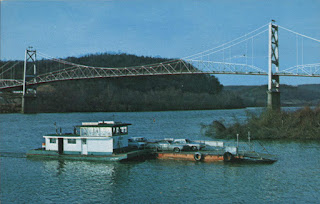This is an abbreviated version for newspaper of an earlier post about the Silver Bridge collapse. To read the full version, including chilling survivor stories, click here.
Cars and trucks packed the iconic Silver Bridge at dusk on a cold Friday, December 15, 1967. People were headed home to and from Gallipolis OH and Point Pleasant WV, anticipating the weekend and Christmas. The bridge swayed with the traffic load. But it always did that; people barely noticed. Suddenly, the bridge, vehicles, and people were gone - like a David Copperfield illusion.
A connecting link in the bridge suspension had broken. The roadway twisted violently - “slithering like a snake,” flipping the vehicles into the river "like children's toys." The entire bridge then fell, trapping many under the bridge superstructure. 46 people perished.
Several survivors were rescued from the water and from mangled steel on the Ohio side. A large truck floated downstream. After that, the scene was eerily quiet. The most shocking aspect to onlookers was what wasn’t there: the bridge. The Ohio River had swallowed up everything.
The 1760-foot-long Silver Bridge was a graceful suspension bridge, built in 1928 on the Ohio River, connecting Gallipolis, OH and Point Pleasant, WV. Its bright aluminum paint earned it the “Silver Bridge” moniker. The bridge was an elegant landmark, pride of the region, and a vital transportation link.
Photo by author of 1930s tourist brochure extolling the virtues of the Silver Bridge - and encouraging travelers to use it. CLICK TO ENLARGE
The Silver Bridge disaster changed thousands of lives in both communities. Family and friends grieved the losses. Witnesses and first responders suffered nightmares, fear of water, and anxiety about crossing bridges. Christmas season thereafter was difficult for many. And the beloved bridge itself was gone and with it the connection between the two towns.
Several Marietta area people were soon present at the disaster scene. Washington County Sheriff Richard Ellis and a few deputies drove to the site to help with emergency crews. Ellis's vehicle had a public address speaker. They used that for crowd control and other activities.
Don Yoho, Larry Barnes, and Guy Meeks from Washington County were employees of Hocking Valley Steel working on a job just north of Gallipolis. They helped extract a trapped man from a truck and brought a truck crane from their job site to help. Cliff Winstanley, Jr., the Game Warden for Washington County, was on law enforcement duty there the day after the tragedy. One of his tasks was to keep unauthorized persons away from the scene on the Ohio side.
There were Marietta area traffic impacts. The Hiram Carpenter Bridge (see photo) connecting Newport OH and St. Marys WV had the same design as the Silver Bridge. Though it carried far less traffic, it was closed as a precaution and later replaced. The Interstate 77 Ohio River Bridge at Marietta, was scheduled to be opened the following Monday. Ohio Governor James Rhodes and West Virginia Governor Hulett Smith conferred Friday evening and decided to open the new bridge that night. The Ohio Highway Patrol notified Marietta Police. Road crews scrambled to move barricades and uncover signs.
Photo of the original Hi Carpenter Bridge in 1970. The ferry in the foreground was used after the bridge closed in 1967. CLICK TO ENLARGE
S. Durward Hoag was given the honor of being the first to cross the new bridge. He was the owner of the Hotel Lafayette and a tireless civic booster. He was credited with influencing the decision to add I-77 to the Interstate system. He drove across at 10:19 p.m. Marietta Mayor John Burnworth and Williamstown Mayor Aubrey Rymer joined the procession.
One positive Silver Bridge legacy was a new emphasis on bridge inspections and safety. Five days after the Silver Bridge tragedy, President Lyndon Johnson appointed a task force to study bridge safety. The Highway Safety Act of 1968 passed on August 24, 1968, formalized a program for bridge safety nationwide.



No comments:
Post a Comment